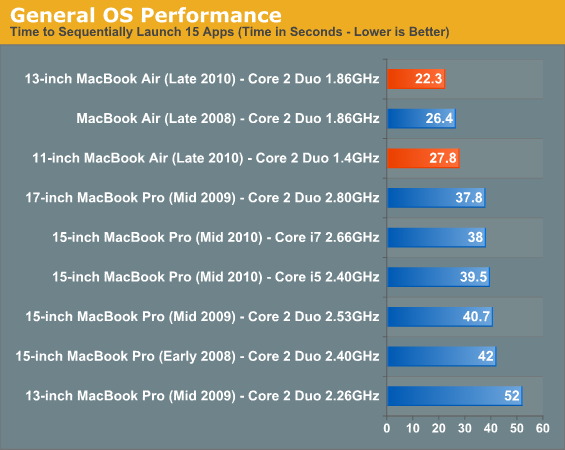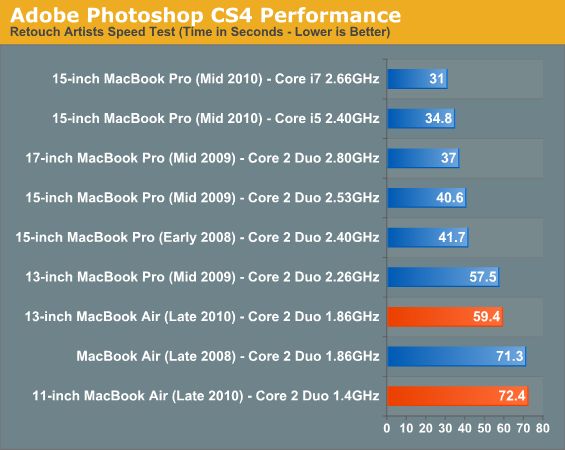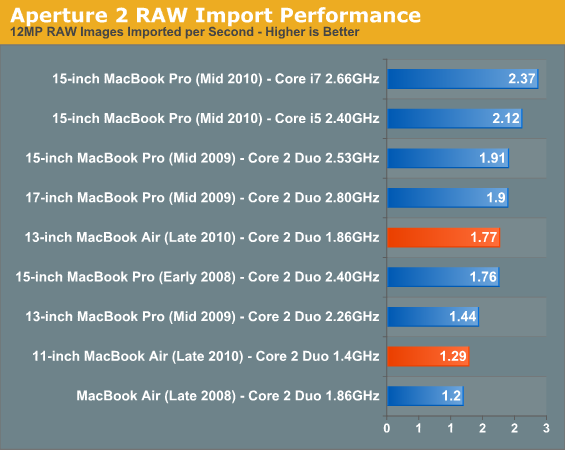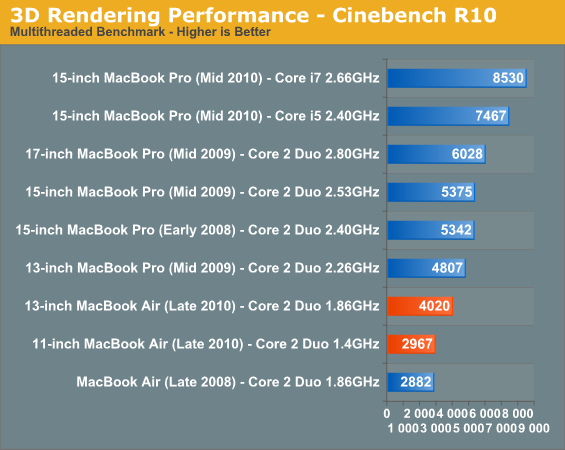Apple's 2010 MacBook Air (11 & 13 inch) Thoroughly Reviewed
by Anand Lal Shimpi on October 26, 2010 10:08 PM EST- Posted in
- Mac
- Apple
- MacBook Air
- Laptops
Performance
Benchmarking under OS X isn’t difficult, you just need to get creative. Luckily I’m in dire need of creative outlets so creating OS X benchmarks works for me. I’m using the same tests I introduced in my Holiday 2009 Macbook Pro roundup and running on the launch hardware for each notebook listed in the charts.
We’ll start with general application performance.
General OS usage is a difficult thing to quantify, but one measure of performance has always been the number of bounces an icon in the dock makes before an application loads. I decided to take it to the next level and write a quick script to launch 15 applications in a row, timing how long the entire process takes.
I launched, in order: Mail, Safari, Activity Monitor, iTunes, iCal, DVD Player, iPhoto, Photo Booth, Quicktime Player, Disk Utility, Preview, iMovie, Front Row, Garage Band and Aperture.
The entire process stresses both the disk and CPU, which is why we see a huge improvement when going to an SSD as well as differences between CPU speeds.

What a difference an SSD can make. The 13-inch MacBook Air is the fastest standard shipping configuration Apple offers in this benchmark. The fact that there's a measurable difference between the 13-inch and 11-inch models shows you just how slow that 1.4GHz Core 2 really is.
Adobe Photoshop CS4 Performance
The Retouch Artists Speed Test we use for our CPU testing under Windows also works under OS X. We're running the exact same benchmark here, basically performing a bunch of image manipulations and filters and timing the entire process.

The 13-inch MacBook Air performs as well as last year's 13-inch MacBook Pro. But if you plan on doing real work, you'll be hampered by the performance of these systems. Apple really needs to find a way to get an Arrandale or Sandy Bridge into this chassis
Aperture 2 RAW Import
For my Aperture test I simply timed how long it took to import 203 12MP RAW images into the library.

The SSD makes the 13-inch MacBook Air far more competitive than it should be here. It's even faster than a two year old 15-inch MacBook Pro. The 11-inch MBA is faster than the old 13-inch MBA due to its better thermal characteristics as we pointed out earlier.
Cinebench R10
I’m a fan of the Cinebench test because it lets me show off both single and multithreaded performance in the same workload. First, the single threaded performance:


The performance in both of these tests in line with the rest of the results. These notebooks aren't very good at intensive workloads. It is worth pointing out that the 13-inch MacBook Air posts better numbers here than the old dual processor 2.5GHz PowerMac G5 :)
Quicktime H.264 Video Encoding
Our final benchmark is more consumer focused. Here I'm taking an XviD and converting it to an iPhone-supported H.264 format.











185 Comments
View All Comments
solgae1784 - Wednesday, October 27, 2010 - link
Retracting my last part of my comment.....Dell XPS 15" line does have a 1080p option.Accord99 - Thursday, October 28, 2010 - link
Lenovo offers a 1920x1080 option on the T510/W510, Dell also offers it on their Studio 15, Latitude E6510 and Precision M4500 models. Asus has a number of models like the N and G which have this option, as does Sony, including the expensive 13.3" Z.Penti - Thursday, October 28, 2010 - link
Business laptops like from HP, Dell, Toshiba, Lenovo, Sony and Fujitsu has high-res screens, 13.1" 1600x900 displays, 14" 1600x900 displays, 15" 1600x900 displays and 1920x1080, and so on. (With Dell think E5510 or E6510). Those start at ~999 dollar though. But everything isn't consumer shit.ssd_trimmer - Tuesday, October 26, 2010 - link
I understand that Mac OS X does not yet support TRIM, but does the underlying SSD support it? I hope to run Fedora on a Macbook Air 13.MacTheSpoon - Tuesday, October 26, 2010 - link
As a writer, I paid a premium for my Vaio X so I could have a very light machine with all-day battery life and a bright, matte screen to use outside on sunny days. The tradeoffs have been a cramped keyboard (especially annoying for its horribly small "shift" key); a puny track pad (without two-finger scrolling, which I really miss); and a sluggish processor.I had some hope that the 11" MBA might be a viable alternative, but its lack of a matte screen, its low battery life (compared to a good netbook and certainly compared to my 12+ hour Vaio X), and even its surprisingly high weight for its battery life are keeping me from switching over, even taking into account its fantastic keyboard/track pad that I am drooling over with envy.
Furthermore, thought it's more an observation than a major purchasing reason for me, comparing the two premium netbooks I have to give the edge to the Vaio X in terms of razzle dazzle factor, too, which is sad. I really thought Apple could one-up Sony in this respect. I'm not talking visual design as much as overall "cool" factor. How cool is it that I can swap out my extended battery and have a laptop that weighs as much as an iPad but plays Flash and lets me run desktop class programs? And even its ridiculously large maximum screen angle thrills me after years of suffering from my 15" 2007 MBP; I can open up the Vaio X screen so wide that it's practically flat. It's so comfortable to sit in bed and type with it propped against my knees and its screen wide open.
Anyway, I sure would have liked the 11" MBA to equal the Sony in its battery life and weight, and to throw in a matte screen for good measure, because I knew Apple would get the keyboard and track pad right--which they did. A similarly large screen opening angle would have been great, too. Then I would have switched very, very happily. As it is, I just can't justify it. I can't give up this battery life and outdoor suitability, even if typing is somewhat irritating.
solipsism - Tuesday, October 26, 2010 - link
The Vaio X runs an Atom CPU with an Intel GM500 IGP. When running the same Light Browsing test as Anand how much time can you actually get from your Vaio X? It’s really a $1300 netbook. It’s a great machine except for CPU/GPU/RAM, but you pay a lot for it. As for weight, it’s the same weight for the Vaio X once you pay extra for the 12 hours battery (that I hear gets you about 8-9 from Light Browsing).I disagree with calling any small ultra-portable a netbook based on the display size. These came about because of the cheap, low-power and slow Atom CPUs, and built up from that was the rest of the cheap HW, with a small display and cramped keyboard. The 11” MBA is not any of those things. That CPU alone cost more than most netbooks.
Wilcomhs - Tuesday, October 26, 2010 - link
Can we have some numbers for battery life under Win 7 please? 5 hours sounds acceptable but knowing the battery life hit going from OSX to Windows would help with making a decision here.CharonPDX - Wednesday, October 27, 2010 - link
Find me one other Core 2 Duo SU9400 equipped notebook that weighs under three pounds for anywhere near this price.Find me one other Core 2 Duo SU9400 equipped notebook with anything other than Intel graphics that weighs under three pounds - for ANY price.
The 11" MacBook Air is not a netbook. Repeat that again. The 11" MacBook Air is NOT A NETBOOK. It competes in the "ultra thin/light performance notebook" segment, and it dominates it. It is lighter than almost every other notebook in its class, has the best graphics in its class, hands down (I have found a few four-pound models that have a GeForce 105M,) and it costs significantly less than anything else in its class.
The 13" model has a *LOT* more competition, because at 13", you can actually get moderate graphics and/or a decent price. But in the 11" space, the Air is all by itself.
khimera2000 - Wednesday, October 27, 2010 - link
its a netbook becaus other then web, writing, and instant messaging theres not much more you can do with it. not to mention it impimants its HDD in a similar maner as netbooks, and has no optical drive just like net books, has a weaker video card just like a netbook... this thing is a netbook, becaus theres nothing much else it can do. it fills the lower performance segmant of the notebook market, and its ultra portable which was what the netbook did.Demoure - Wednesday, October 27, 2010 - link
However, optical drives are not as important as they used to be, the video card is more powerful than that of many large notebooks sporting intel graphics, many netbooks use real hard drives, and a laptop of this power can do more than just web, writing, and messaging. It will manage to play movies, to photo editing, and low end gaming just fine, and I can't think of anything else you would want to do with a mobile device?